Hustler: Refurbishing Dad's Thunderbolt
by Mike Darby
Continued
After my dad bought the new boat, my grandpa (Bill) took the boat back and he continued to fiddle around with and enjoy it. I would hassle him at every family function about bringing it back and letting me have it. This went on for years.
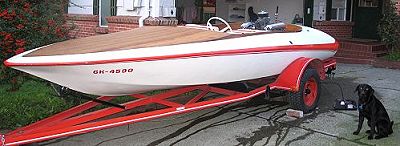
Finally, Nicole and I decided to get married (2002)
and my grandpa had commented that it would come back as a wedding gift. Well we
got the Hustler back two years after we were married (2004) but hey, I
wasn't 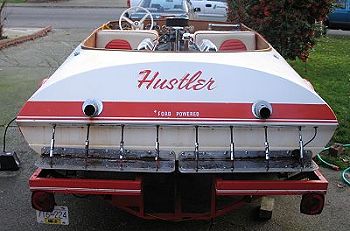 complaining, I just
wanted to get it out on the water. It was perfect timing as Nicole and I were
only two days away from going for a holiday up in Osoyoos.
complaining, I just
wanted to get it out on the water. It was perfect timing as Nicole and I were
only two days away from going for a holiday up in Osoyoos.
Unfortunately, the boat is now 40 years old and it has seen its day. The mahogany was dried out, the plywood was drying out and the cracks were coming through the fiberglass on the outside of the boat, the paint was faded and it was overall just plain tired.

So, we used the boat for the rest of the summer in 2004 and did some research during the fall about what to do to restore it. Several questions: Is it worth it? How much do I spend? Where do you start?
Well, being a person who is not scared to attempt things myself, I decided that I would do it all and do it all myself.
I started by removing the filler that covered the screws that held the plywood to the gussets and replacing almost every screw as you could tell through the gel coat and fiberglass where each screw was. I then filled each hole again with new filler and sanded it smooth.
One of the biggest problems with the boat was that it did not get right out of the water on plane. Bill figured that this was due to the chine being too rounded. So when would be a better time than the present to fix this problem. I proceeded to cut a piece of oak two by three on the diagonal. I attached the new piece of oak to the chine, thereby sharpening the chine and directing the water away from the boat and theoretically getting the boat out of the water more.
  |
The new chine was attached with stainless steel carriage bolts, glued, and then fibreglassed into place. Then, after a lot of filling and sanding, the boat was primed, painted, pin striped, and decaled. The original paint scheme was cream and orange; of course the cream was way too dated for the new Hustler. I repainted the boat bright white with a fire engine red stripe and red lettering. The new chine fit in and looked perfect. It's as if it was always shaped that way.
After forty years of use, it was time to tackle the interior. The electrical was a mess considering it had been converted from a Ford 332 to a 390, a generator to an alternator and new accessories had been added, it was a rats nest. I tidied it up, replaced a lot of the wiring, added some newer technology, and now it should last for another forty years.

Other than the electrical, the steering wheel was in desperate need for an update. The big white old wheel was considerably out, and a new chrome and black wheel was installed. This of course, was not done without its own problems. I had to find an adapter for the tapered shank which should have been easy but this was not the standard ¾ inch taper. I ended up cutting the center of the old wheel out (fortunately it was aluminum), and I was able to polish it, and thread it to mount the new wheel and match the new chrome.
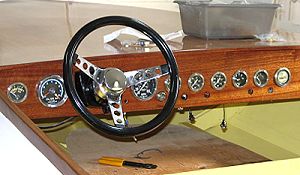
My wife also had to have her say with the interior, which was originally cream and orange. It was replaced with a new white and red racing strip theme. The red that we chose for the interior was used to match the new red paint on the outside of the boat. Also, the old floorboards were a rubber-type grip glued to the plywood; this was removed and replaced with new black carpet for a comfortable feel on the feet and a sharp look.
After the interior was complete it was time to refinish the mahogany. We sanded down the varnish to the bare wood and started from scratch. The bare wood was then covered with ten coats of epifanes varnish to give it that traditional shiny finish.
Now at this point I should have been finished with
the boat restoration, but as with any other project there are often unforeseen
costs. As noted above, I have not mentioned anything about the motor. Well, as
mentioned, it was changed to a 390 and when it was changed it was rebuilt, this
was approximately in the early 1990's, one would think that it should still
be okay. Well it wasn't, apparently before I put it away
for the winter I created a circumstance where water got in the cylinders and
has been there since the tear down. Yeah, so it had to be rebuilt. Well on the
positive 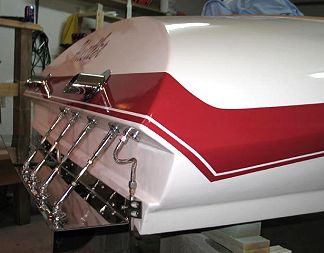 side, the block was
repainted from orange to black and I was able to repaint under the motor and
paint the rest of the components black… It looks really sharp now!
side, the block was
repainted from orange to black and I was able to repaint under the motor and
paint the rest of the components black… It looks really sharp now!
At this point the boat has been completely rebuilt, and I have not left anything untouched.
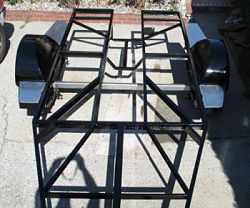
I also re-did the trailer. The trailer was originally orange, steel rims and pretty plain. I re-painted the trailer black, added checker plate steps, hydraulic disc brakes, chrome rims, a new crank wheel at the front for moving the boat around and replaced the wiring. Now the whole boat can ride in style.
I look forward to using the boat this summer with my wife, and look forward to sharing it with my kids as we are expecting our first at the end of September. As my dad says "what better time would there be to have a boat..."
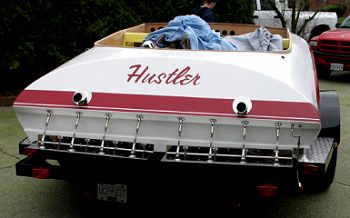
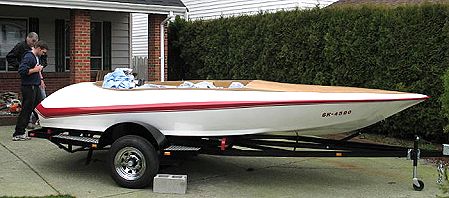
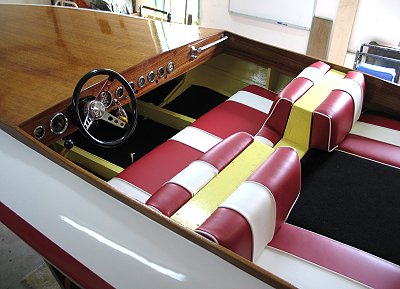

PS: By the way, I got it running today... it sounds wicked!
We look forward to a performance report. I don't really know what affect the wedge will have on the performance of the boat. There could be some minor turbulence as the chines are not completely parallel. ...brw